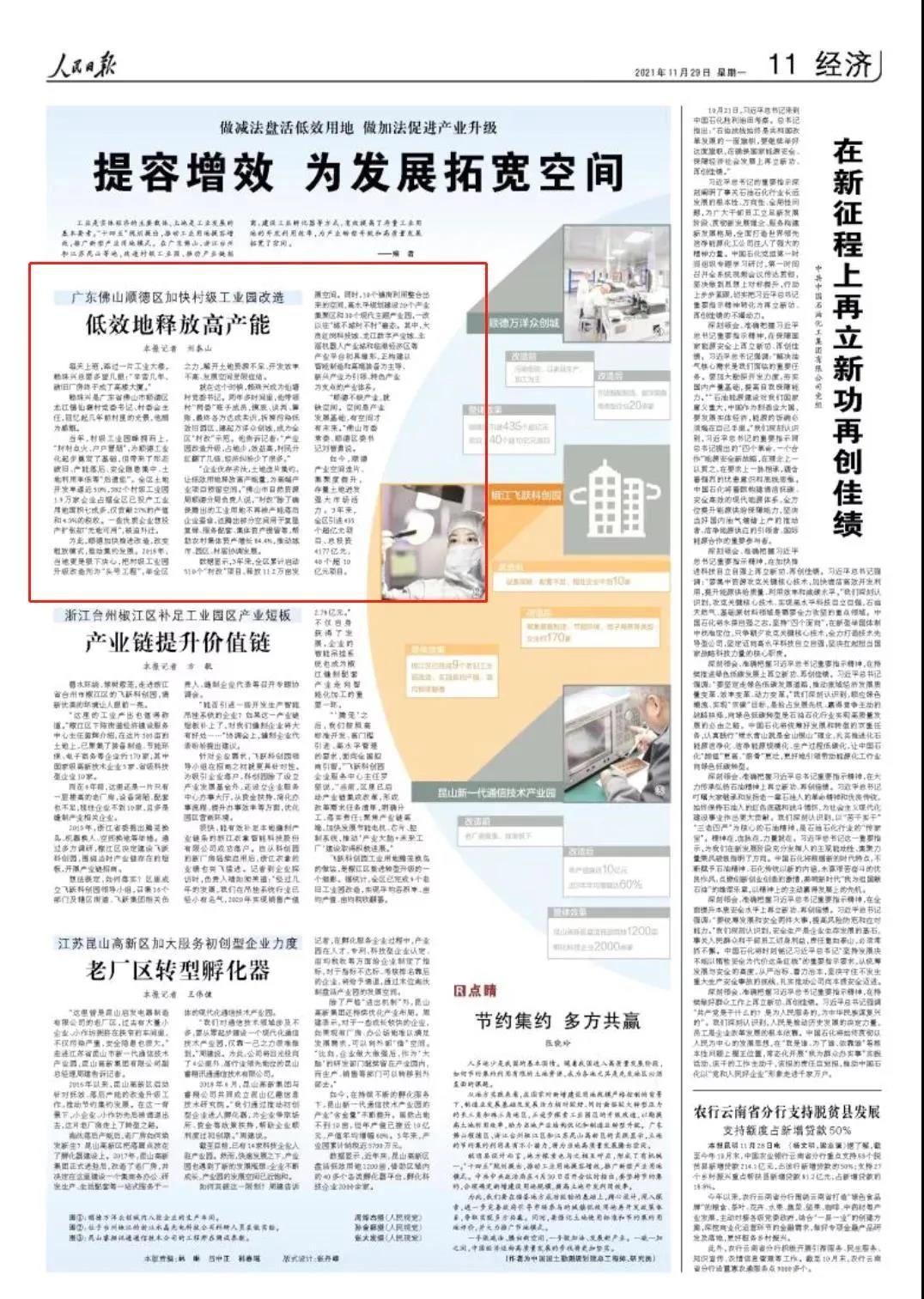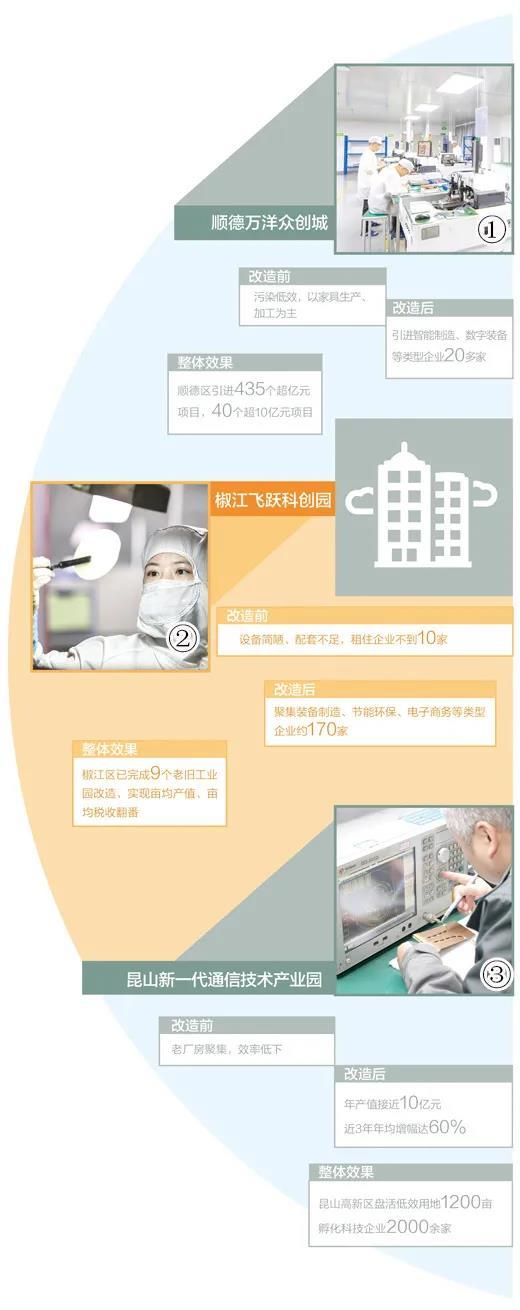
Increasing Capacity and Efficiency to Expand Development Space - People's Daily Praises Wanyang Innovation Park

On November 29, People's Daily's economic section published an article titled "Improving Capacity and Efficiency to Expand Development Space," reporting on Shunde's efforts to transform village-level industrial parks. Shunde Wanyang Innovation City, as a model project for Shunde's village transformation, effectively improved the development and utilization efficiency of existing industrial land, promoting the contiguous expansion and increased aggregation of industrial space.


Figure ①: The production workshop of an enterprise in Shunde Wanyang Innovation City. Photographed by Zhou Chaojie (People's Vision)
Figure ②: Researchers at Zhejiang Crystal Optoelectronics Technology Co., Ltd. in Jiajiang, Taizhou, conducting experiments. Photographed by Sun Jinbiao (People's Vision)
Figure ③: Engineers at Kunshan Ruixiang Xuntong Communication Technology Co., Ltd. adjusting parameters. Photographed by Zhang Dafa (People's Vision)
Industry is the main carrier of the real economy, and land is a fundamental element for industrial development. The "14th Five-Year Plan" proposes to improve the capacity and efficiency of industrial land use and promote new models of industrial land use. In Guangdong Foshan, Zhejiang Taizhou, and Jiangsu Kunshan, methods such as transforming village-level industrial parks, promoting industrial chain investment attraction, and building industrial incubators have effectively improved the development and utilization efficiency of existing industrial land, expanding the space for industrial transformation and upgrading and high-quality development.
Shunde District, Foshan City, Guangdong Province Accelerates the Transformation of Village-Level Industrial Parks
Low-efficiency land releases high-output capacity
Every day on his way to work, passing by a cluster of industrial buildings, Lai Zhu Xing would always take an extra look. "After years of hard work, the dilapidated factories have finally become high-rise buildings."
Lai Zhu Xing is the Party secretary and director of the Village Committee of Xian Tang Village, Longjiang Town, Shunde District, Foshan City, Guangdong Province. Recalling the situation in the village a few years ago, he felt quite emotional.
In those years, village-level industrial parks sprang up rapidly, resulting in a situation of "every village lighting up, every household smoking," which laid the foundation for the initial stages of Shunde's industrialization but also brought about problems such as dilapidated forms, backward production capacity, concentrated safety hazards, and low land utilization rates. The land development rate of the entire district approached 50%, with 382 village-level industrial parks and 19,000 enterprises occupying more than 70% of the district's already-commissioned industrial land area, yet only contributing 27% of the output value and 4.3% of the tax revenue. Some high-quality enterprises, wanting to expand production, found "no land available" and were forced to relocate.
To this end, Shunde accelerated the pace of transformation, changing its extensive model and promoting intensive development. In 2018, the local authorities made a firm decision to list the upgrading and transformation of village-level industrial parks as the "top priority project," mobilizing the entire district's efforts to address the issues of insufficient land resources, low development efficiency, and limited development space.
It was at this time that Lai Zhu Xing became the Party secretary of Xian Tang Village. In just over two years, he led the village's "two committees" to conduct surveys, negotiations, and calculations, ultimately reaching a consensus among all parties. The dilapidated and inefficient old industrial park was demolished, and Wanyang Innovation City was built, becoming a model for "village transformation" in the entire district. He told the reporter: "The transformation and upgrading of the industrial park has reduced land usage while increasing efficiency, resulting in several times the increase in villager dividends and a significant reduction in economic disputes."
"The survival of the fittest among enterprises and the integrated and intensive use of land have released high-output energy from inefficient land, reserving space for high-end industrial projects." A person in charge of the Shunde Branch of the Foshan Municipal Bureau of Natural Resources said that the "village transformation" not only ensures that the reclaimed industrial land will not be encroached upon by enterprises with backward production capacity, but also allocates part of the space for land reclamation and afforestation, supporting facilities, and collective asset retention, helping rural collective assets grow by 84.4% and promoting coordinated development of cities, parks, and villages.
Data shows that in the past three years, a total of 510 "village transformation" projects have been launched in the district, releasing 112,000 mu (approximately 7467 hectares) of development space. At the same time, 10 towns and streets have utilized the integrated space to high-standardly plan and construct 20 industrial agglomeration areas and 30 modern thematic industrial parks, changing the previous "neither city nor village" predicament. Among them, industrial platforms such as Daliang Honggang Science and Technology City, Longjiang Digital Industry City, Beijiao Robot Industry City, and the Lingang Economic Zone have taken initial shape, building an industrial system led by intelligent manufacturing and high-end equipment, guided by emerging industries, and supported by characteristic industries.
"Shunde doesn't lack industries, it lacks space. Space is the foundation for industrial development; with space, there is a future." Liu Zhiyong, member of the Standing Committee of the Foshan Municipal Committee and secretary of the Shunde District Committee, said.
Today, Shunde's industrial space is contiguous and its aggregation level has improved, with existing land bursting with strong market vitality. In the past three years, the district has introduced 435 projects exceeding 100 million yuan, with a total investment of 417.7 billion yuan , 40 projects exceeding 1 billion yuan.
